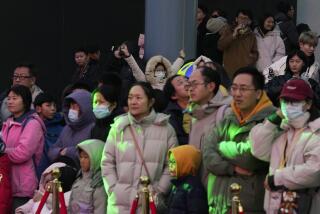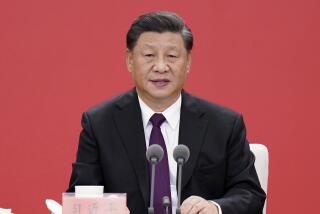China lowers GDP growth target for the first time in 8 years
- Share via
Reporting from Beijing — China has lowered its official growth target for 2012, sending the clearest message yet that the world’s second-largest economy isn’t likely to keep expanding at its previous steroid-charged pace.
Speaking to about 3,000 delegates Monday at the annual meeting of the National People’s Congress in Beijing, Premier Wen Jiabao said China would cut its annual gross domestic product growth target for the first time in eight years, to 7.5% annual growth from 8%, to make the country’s economy more “sustainable and efficient.”
That half a percentage point may not seem like much. But in China, it broadcasts a signal to policymakers, both national and local, that development will have to strike a better balance.
Swaths of empty luxury apartment blocks, environmental degradation and violent rural protests over land seizures are just some of the ways that ordinary Chinese can point to vast inequities generated by no-holds-barred development.
“The announcement today means China will not simply chase after high-speed growth,” said Hu Xingdou, an economist at the Beijing Institute of Technology. “Instead, it will seek high-quality growth.”
But a reduced growth rate could owe just as much toChina’sdeteriorating trade with Europe and investment constraints brought on by rising public debt and inflation.
China powered through the global financial crisis by loosening credit, encouraging real estate development and investing billions in public works. The resulting property bubble and stress to the banking system mean the government can’t do that again.
With that in mind, the Chinese leadership is lowering the bar and tempering expectations at a time when China is expected to lead the world toward economic recovery.
It’s “a political statement that says, ‘We can’t grow like we’d like to grow,’” said Patrick Chovanec, an associate professor at Tsinghua University’s School of Economics and Management in Beijing. “They’re saying, ‘The economy is slowing and we can’t admit to a hard landing.’ It’s an admission they can’t hit their target.”
China previously signaled slower growth ahead when it released its current five-year plan calling for 7% annual growth from 2011 to 2015, but those medium-range plans typically understate actual GDP expansion. That economic road map also acknowledged the need to gear the nation’s development model for higher-quality growth.
Success will depend largely on the ability ofChina’sleaders to take on entrenched groups. For example, a relatively weak currency has benefited state-owned enterprises and exporters. But it has made imports more expensive for Chinese households, which need to spend more if China is to rebalance its economy.
In a report released last week, the World Bank and a think tank attached toChina’s State Council outlined necessary reforms such as boosting the private sector and the financial industry to empower Chinese consumers.
Beijing will also have to convince local officials that their political careers won’t hinge solely on delivering robust GDP growth. At present, government cadres have every incentive to build empty airports and lavish government offices to ratchet up growth numbers, which in turn has fueled skepticism about the validity of the statistics.
“I don’t believe in GDP numbers,” said Zhou Xiaochun, a sociology professor at People’s University in Beijing. “They’re fairy-tale figures. In China, we say officials create figures and figures create officials.”
In all likelihood, China will report much faster growth than 7.5% this year, barring another global financial meltdown. China far exceeded its 8% target last year, posting a 9.2% increase in GDP.
“It’s never really a target, it’s more about setting a floor for growth,” said Wang Tao, chief China economist at UBS. “We still expect growth above 8%.”
More to Read
Inside the business of entertainment
The Wide Shot brings you news, analysis and insights on everything from streaming wars to production — and what it all means for the future.
You may occasionally receive promotional content from the Los Angeles Times.











